|
The Woodland Education Centre |
|
|
The Woodland Education Centre |
|
Ecological Survey 2001
Autumn Cut Sections (1, 3 and 8)
| (Please note, the colour coding given
to each section description matches that of the Belt Transect
Diagram to aid understanding.) These
descriptions build upon the descriptions of the sections given in the 2000 ecological
survey and should be read in conjunction for maximum benefit. |
Section 1 - Observations 2000 - 2001
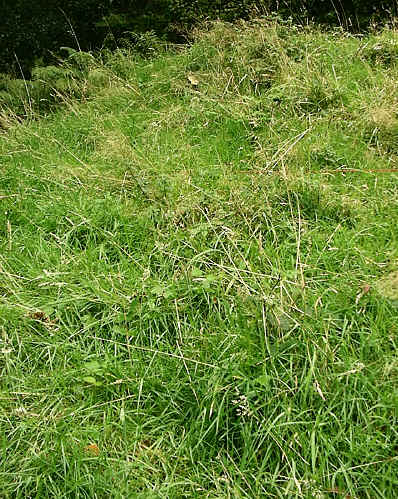 |
As in past years, Common Bent and Yorkshire Fog continued to be the
dominant species in section 1. The section was also still the one most influenced by adjacent woodland. Several woodland species, such as Ivy, Oxalis, Wood Speedwell and Bluebell were concentrated near the neighbouring woodland edge. Notable numbers of tree seedlings, including oak, willow and cherry were also a feature of this section. Rhododendron, which first appeared in this section in 2000, continued to be recorded.
|
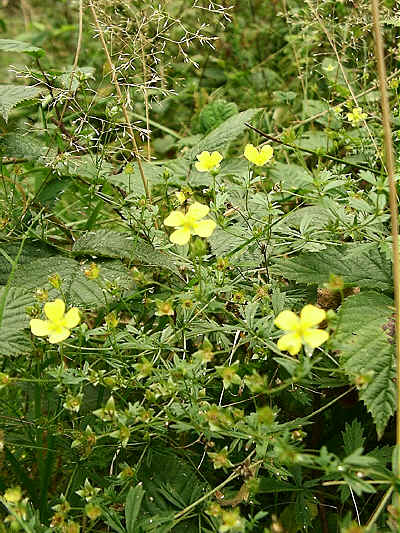 |
Section 1 was visibly less dominated by grasses than in previous years.
Although the grass cover had not decreased substantially, species diversity had increased
by almost 50% from the previous year and a variety of other plants were now interwoven
amongst the grasses. Tormentil (left) a characteristic heath species, had colonized the section in patches. Bramble (left) one of the dominant species in this section, was found in almost half of the quadrats sampled. Using this % frequency as a measure of abundance, bramble had declined from the previous year. However, if mean % cover was used as a measure of abundance instead, bramble had almost doubled. This can perhaps be interpreted as the established bramble plants consolidating and increasing in extent, rather than the development of many new plants over the section. |
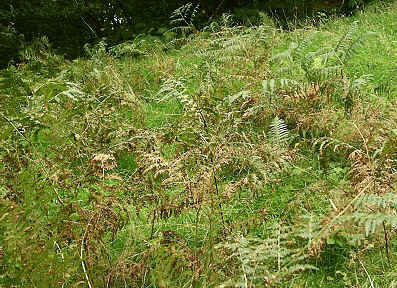 |
The section was characterised by having considerable quantities of Bracken, Narrow Buckler Fern and Hard Fern. |
Section 3 - Observations 2000 - 2001
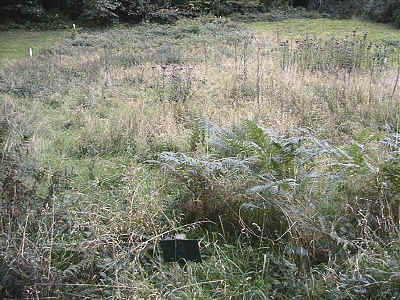 |
Section 3
gave the overall impression of being an area of grassy scrubland, particularly in the
upper half. Yorkshire Fog had declined in this section from the previous year, while Common Bent had stayed more or less the same. |
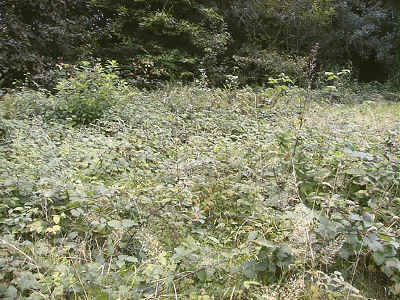 |
The upper half of the section was dominated by brambles and Raspberry, together with tree seedlings, particularly Hazel, cherry, birch, oak and Sweet Chestnut. |
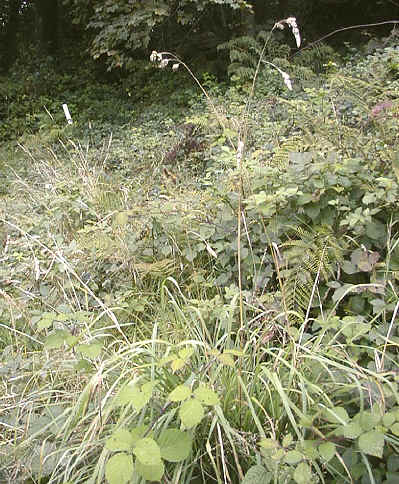 |
There was
some Cock's-foot Grass (left) in the upper half of the section. False Oat Grass continued to dominate in the lower part of the section. |
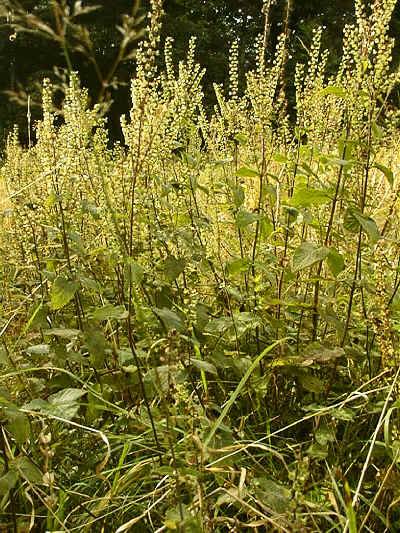 |
Lower down in the section there were more open areas containing
ground-hugging violets, Yellow Pimpernel and Tormentil. Taller plants included Wood Sage (left), some gorse and Marsh Thistles, as well as Hemp-agrimony. |
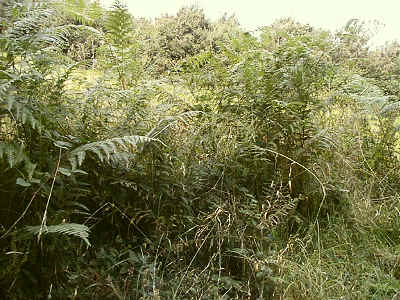 |
Although Bracken (left) was not recorded in any of the quadrats, there was still a considerable stand of bracken both at the bottom of the section and at the top. |
Section 8 - Observations
2000 - 2001
(Autumn cut plus initial general 'weed' control)
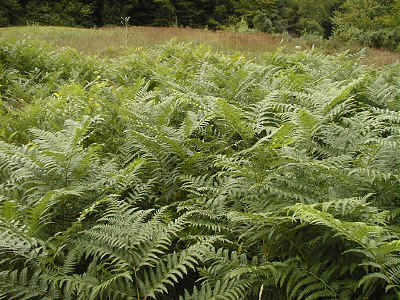 |
Section 8 continued to be a superficially grassy section, dominated by an area of bracken in the lower half (left) |
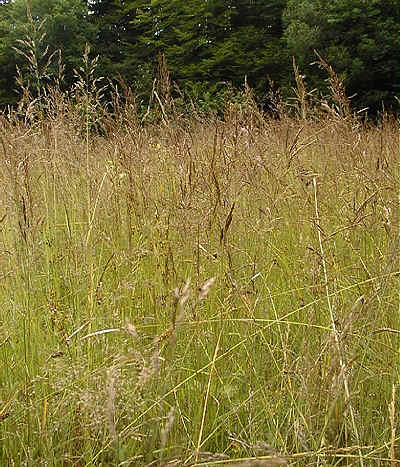 |
Yorkshire Fog declined by more than half in section 8 over the preceding
year. Common Bent (left) in contrast, had greatly increased in abundance in section 8. |
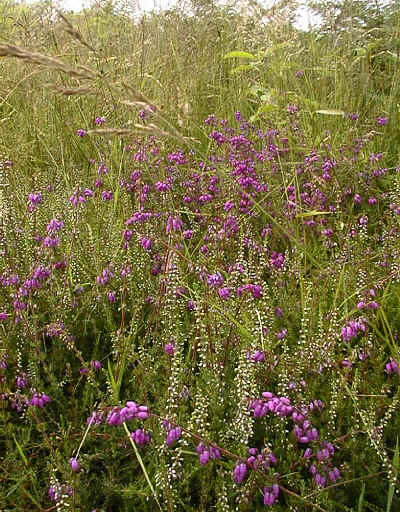 |
The amount of Bell Heather (purple flowers - left) remained approximately the same as the previous year, while
Heather (light pink flower spikes - left) apparently increased
substantially in this section this year. However, it was noted in 2000 that the amount of
Heather in section 8 seemed to have dramatically declined from the previous year. This
data was at odds with visual evidence and it was suggested that this result was a sampling
artefact resulting from the extremely patchy nature of the Heather colonization. This year's results would seem to confirm that assumption, as the amount of Heather recorded had returned to a similar level to 1999. There was perhaps a slight increase in overall mean % cover of Heather in the section over 1999 levels. |
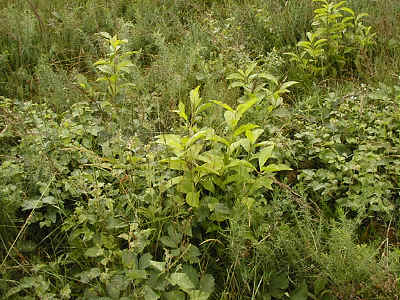 |
Section 8 contained notable quantities of tree seedlings, especially birch,
cherry and willow. Rhododendron clumps were also well established in a few places. Bramble had increased in this section. |
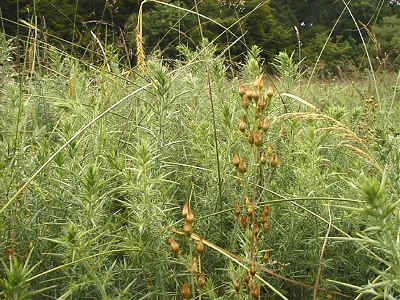 |
There were considerable quantities of European Gorse in the mid region of the
section. The overall amount of gorse in the section had remained more or less unchanged
from the previous year. A small clump of Western Gorse was noted in this section. Tormentil and a variety of sedges were other notable features. |
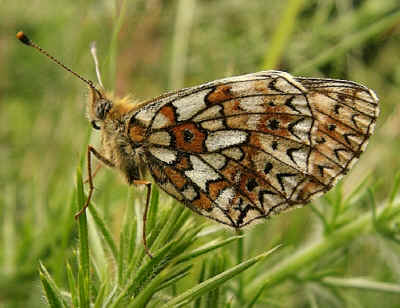 |
The Small Pearl-bordered Fritillary (left), a species which is of conservation concern, was recorded on the project
site for the first time in 2001. It was resting on gorse in section 8. The presence of this species on the Heathland Restoration project site was no accident. Caterpillars of the Small Pearl-bordered Fritillary feed on violets. Violets were the fifth most dominant species across the whole project site in 2001. |
Dominant Plants in
Autumn Cut Sections in 2001
with figures from 2000 for comparison.
Characteristic heath species
are in bold print
A + sign indicates the species was present, but not recorded in the quadrats.
| Species | Section 1 | Section 3 | Section 8 | |||
| Overall % frequency (mean % cover in brackets) | 2001 | 2000 | 2001 | 2000 | 2001 | 2000 |
| Common Bent | 100 (58) | 100 (58) | 97 (40) | 97 (41) | 90 (31) | 66 (7) |
| Yorkshire Fog | 91 (43) | 100 (36) | 68 (11) | 93 (18) | 22 (4) | 42 (9) |
| Eurhynchium praelongum | 91 (41) | 93 (60) | 47 (50) | 90 (54) | 64 (12) | 85 (30) |
| Bluebell | 63 (11) | 72 (6) | 83 (16) | 82 (13) | 0 | 0 |
| Bramble | 48 (22) | 75 (12) | 86 (40) | 61 (15) | 57 (12) | 38 (5) |
| Thuidium tamarascinum | 41 (9) | 68 (27) | 22 (2) | 11 (2) | 32 (12) | 56 (12) |
| Narrow Buckler Fern | 35 (8) | 11 (3) | 7 (5) | 7 (2) | 0 | 0 |
| Bracken | 29 (17) | 22 (15) | 0 | 4 (0.5) | 15 (7) | 12 (5) |
| Polytrichum formosum | 22 (13) | 29 (7) | 7 (0.5) | 0 | 57 (33) | 52 (23) |
| Wood Sorrel | 22 (3) | 22 (1) | 0 | 0 | 0 | 0 |
| Silver Birch | 10 (4)) | 18 (2) | 25 (7) | 14 (3) | 32 (14) | 30 (4) |
| Hypnum jutlandicum | 10 (1) | 15 (2) | 0 | 11 (2) | 54 (28) | 59 (15) |
| Common Dog-violet | 7 (0.3) | 18 (1) | 86 (27) | 90 (40) | 22 (3) | 30 (3) |
| Raspberry | 7 (1) | 0 | 57 (10) | 25 (7) | 0 | 0 |
| Yellow Pimpernel | 3 (0.3) | 0 | 54 (9) | 32 (4) | + | 0 |
| Green-ribbed Sedge | 0 | 0 | 0 | 0 | 82 (30) | 19 (3) |
| Yellow Sedge | 0 | 0 | 40 (7) | 0 | + | 0 |
| False Oat Grass | 0 | 0 | 40 (17) | 25 (9) | 0 | 0 |
| Heath Speedwell | 0 | 0 | 32 (2) | 36 (4) | 15 (3) | 12 (5) |
| Bugle | 0 | 0 | 40 (6) | 29 (5) | 4 (0.4) | 12 (0.2) |
| Cherry | + | 0 | 4 (0.4) | 0 | 29 (3) | 34 (2) |
| Hedge Woundwort | 0 | 0 | 42 (4) | 61 (19) | 0 | 0 |
| Velvet Bent | 0 | 0 | 7 (4) | 25 (7) | 29 (5) | 93 (52) |
| Greater Bird's-foot Trefoil | 0 | 0 | 42 (15) | 47 (18) | 4 (0.4) | 0 |
| European Gorse | 0 | 0 | 7 (6) | 15 (2) | 57 (25) | 70 (26) |
| Heather | 0 | 0 | 0 | 0 | 57 (26) | 19 (11) |
| Slender St. John's-wort | 0 | 0 | 18 (0.5) | 7 (0.5) | 68 (8) | 74 (9) |
| Percentage frequency = the percentage of the total number of quadrats sampled over the whole site which contain the species. For example, a percentage frequency of 100%, means that the species was found in all quadrats sampled. |
>> Continue to Spring, Summer and Autumn Cut Section
Ecological Survey 2001 |